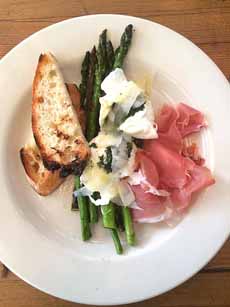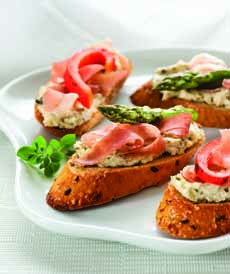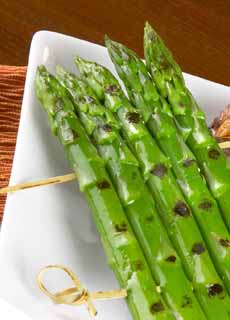TIP OF THE DAY: Asparagus Season Tips, Tricks & Recipes
|
Our favorite harbinger of spring has landed in the market. There are numerous spring fruits and vegetables that are eagerly awaited by food enthusiasts; but our favorite is asparagus.
Fresh-harvested domestic asparagus is as flavorful and affordable as it gets. Bonus: asparagus has just three calories per medium spear, and contains no fat or cholesterol. It’s also nutritious: > Check out the delicious asparagus recipes below. > Also below, tips on purchasing and preparing asparagus. Asparagus officinalis was first cultivated more than 5,000 years ago in the eastern Mediterranean region. The oldest reference shows the spring vegetable on an Egyptian frieze dating to 3000 B.C.E. The delicate asparagus plant needs a temperate climate and requires much hand labor in all phases of cultivation; hence, their higher cost. White Asparagus, Purple Asparagus White asparagus is a special treatment of conventional asparagus, grown for its color. The spears must be grown under a layer of topsoil or in the dark without exposure to sunlight. Light would engender photosynthesis and the development of green chlorophyll. The growing technique was developed in France in the mid-1600s. If you come across fresh white asparagus and want to see if the extra cost is worth it, steam them with a bit of salt and taste their nuances before adding butter or another ingredient. You may or may not find a difference worth the money. Never buy bland, canned white asparagus. Here’s more about white asparagus as well as purple asparagus, a breed that is larger, sweeter and tastier than the conventional green types of asparagus. Purple asparagus was originally developed in Italy by farmers in the Albenga region of the Italian Riviera. It was first commercialized under the variety name Violetto d’Albenga. Purple asparagus retains its color if cooked briefly (blanching, quick sauteing), but reverts ti green with prolonged cooking. Buying Asparagus Look for firm stalks of uniform width and a minimum amount of woodiness at the end. It doesn’t matter if they’re thick or slender: both are equally tender. But you need uniformity of size to cook them evenly. The tips should be tightly closed. Once they begin to separate, it means that the asparagus is older and won’t have the best fresh flavor. If your tips have begun to wilt, soak the spears in an ice bath before cooking. Vegetables wilt when they dry out. You can restore the moisture with an ice bath: Fill a bowl with water with ice cubes. Add the vegetables (cut as you plan to use them) and let them sit for 15 minutes or longer. Remove with a slotted spoon or tongs and drain on a cloth or paper towel and they’ll be crisp. Preparing Asparagus Asparagus can be boiled, grilled, roasted, steamed, tossed into soups and stews, and eaten raw as crudités. Most cooking instructions tell you to hold a spear of asparagus in both hands and bend it until it snaps at its natural break point (which is 1-2 inches above the base). That produces rough, uneven bottoms. We simply trim them with a knife as far as the green portion goes. Other instructions tell you to peel the surface of the bottom quarter if they are woody. We don’t have this problem, even with the thickest asparagus. But if you’ve trimmed the white bottoms and still are concerned about woodiness, here are two options: |
 [1] Asparagus Scramble (here’s the recipe from California Asparagus CommissionCalifornia Asparagus Commission).
[5] Asparagus Crostini from Nestle USA | WordPress. Use hummus or bean dip as the base. |
|
|
Cooking Asparagus Boiled Asparagus: Bring a pot of salted water to a rolling boil, then gently tip in your prepped asparagus. Boil for 2 minutes or until the asparagus are bright green and al dente. Take them out and lay it in a single layer to cool. Top with chopped hard boiled eggs and herbs for a light lunch, or puree with a little green garlic for a simple pasta sauce. Grilled Asparagus: Asparagus will slip through the grill if you don’t use a vegetable basket or skewers. We actually like the skewer technique, which creates a rack of asparagus. Simply skewer four or five medium or thick asparagus together, brush with olive oil, season to taste, and cook on a hot, preheated grill Preheat grill for high heat for 2-3 minutes per side (depending on thickness), or to desired tenderness. Before you add the oil, however, use the ice bath technique described above. When the asparagus come off the grill, they’ll be moist and crisp. Raw Asparagus: After trimming, use a vegetable peeler to remove the skin below the spear. We like to slice it thinly on an angle to create ovals, to add to salads and grain bowls, but you can also peel it into delicious ribbons. Reserve the tips of the asparagus and mix them in with the rest! Roasted Asparagus: Heat the oven to 400°. Toss prepped asparagus on a parchment-lined baking sheet with a glug of olive oil and a large pinch of salt and roast for 5 minutes or so—until crisped at the tips and slightly browned. Steamed Asparagus: Simply steamed fresh asparagus at peak flavor is so delicious, that we find it needs no embellishment—no salt, balsamic drizzle, butter, lemon juice or another seasoning beyond a pinch of salt. It requires just a quick visit to the vegetable steamer (or microwave) to be ready to eat. (Note: While some people love it, we think that a vertical asparagus steamer is a waste of space.) But if you do have a bottle of balsamic glaze or balsamic cream, bring it out! |
||





